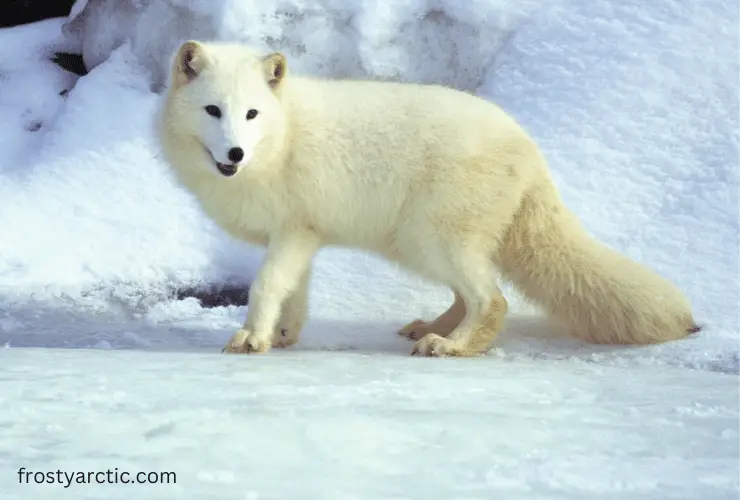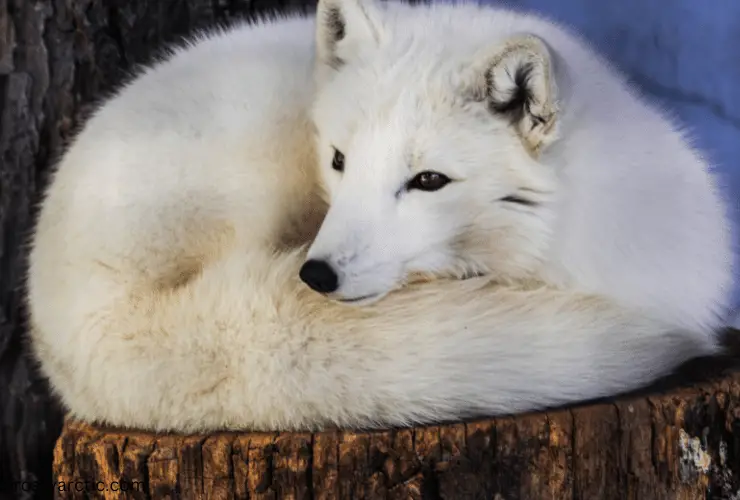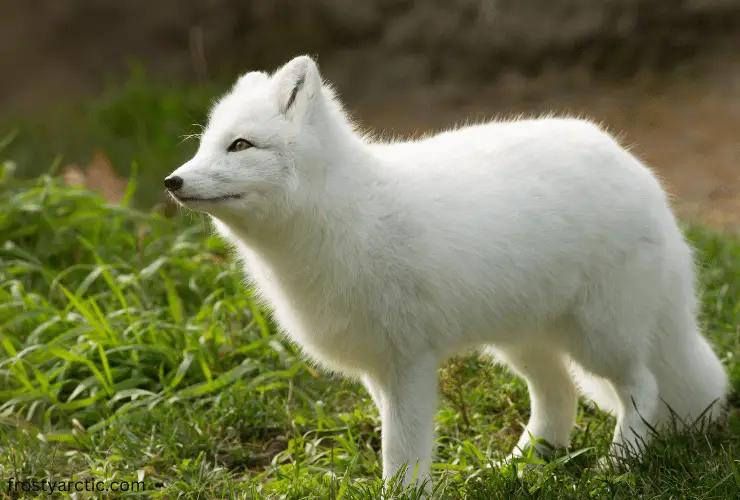Arctic foxes are best known for their white fur, which protects them from the frigid temperatures of the Arctic tundra. The thick, multi-layered fur keeps them warm even below−70 °C. Plus, the white coat has a seasonal camouflage which prevents them from attracting the attention of predators.
If you look at the Arctic fox on the snow, you will not be able to see anything but a pair of black eyes staring back at you! This is how effectively their fur coat hides them from predators. Let’s learn more about their white pelage in this article.
Why Do Arctic Foxes Have White Fur?
The iconic white fur of Arctic foxes is not just an eye-catching feature for these animals; it serves two primary functions: insulating against the cold and survival.
Research suggests that most Arctic foxes inherit their fur color. A dominant allele might result in a blue morph. However, over 90% of the arctic fox population boasts white fur.
In colder areas, white-colored fur is a more effective blanket compared to colored hair.
White hair contains no pigment, which means it is hollow inside, allowing it to trap air. Air is a poor conductor of heat and prevents Arctic foxes from getting cold, even in frigid temperatures. ~ ADGF.Alaska.GOV

On the other hand, colored hair is a better absorber of heat. But that will not be an effective insulator for animals living in the Arctic tundra. Why? Because the heat of the Winter sun is not warm enough to be of value to Arctic foxes.
This phenomenon is common for other Arctic animals with white furs, such as polar bears and even caribou with similar hollow hairs coats.
How Does the Arctic Fox’s Fur Help It To Survive?
Apart from protecting these animals from the cold, Arctic foxes’ fur plays a key role in helping them survive in the wild. Here are some ways their coat helps them survive:
1. Camouflage
Insulation against the cold is not enough to survive the Arctic tundra. Arctic foxes need to hunt and hide from predators. These animals benefit from their fur, which effectively camouflages them throughout the year.
Their color-changing fur helps them blend in with their surroundings, giving them an advantage as prey and predator.
As the season changes, so do their fur color through a process called molting which will be explained later in this article.
2. Protection From the Cold
We already know that the fur of Arctic foxes’ keeps them warm in frigid temperatures.
Did you know? Fur length is almost doubled during the Winter season compared to the summer months. These differences were more apparent on different sites of the foxes’ bodies. ~ Source
The areas of the fox’s body exposed to the cold are much longer and change more (in length) compared to the protected sites when the fox is curled up.
The well-covered areas prevent heat loss for Arctic foxes, while the areas with less fur coverage tend to allow heat to escape more easily, especially during exercise.
From December to February, the fur length is longest than it is throughout the year. As the temperatures begin to rise from March to June, fur length starts to decrease, helping foxes adapt to the warmer temperatures.
3. Movement and Protection
Arctic foxes also have fur on their paw pads which insulates their paws from the cold and acts as “snow shoes” that prevent them from sinking into the deep snow.
Their built-in snow boots also strengthen their grip on the slippery snow, allowing them to escape predators or chase after their prey, both of which are necessary for survival.
The thick fur padding also muffles their footsteps, helping them catch their prey without being noticed. It also makes it difficult for predators to catch these animals. ~ National Geographic
Why Do Arctic Foxes’ Fur Change Color?
Arctic foxes change fur color because of daylight and genetics. Cold weather is not the trigger for shedding and growing fur.
The hours of daylight change as seasons change. As a result of the changing photoperiod, the secretion of hormones, including prolactin and melatonin, is triggered.
Studies have shown that a reduction in photoperiod promotes hormone production, which induces fur growth.
During the Winter, Arctic foxes feature a white coat, but as summer approaches and the snow starts to melt, these animals shed their thick coat and replace it with a brown one.
Melanin is responsible for the brown coat of Arctic foxes. It helps them blend in with their surroundings and hide from predators or hunt for prey.

Genetics also plays a key role in changing fur colors.
For instance, Arctic foxes that live farther up north remain white throughout the year because of permanent snow and ice. Others change color from brown to white (in winter).
Note: The fox species with blue fur shed their winter coat (which is blue) and replace it with a bluish-gray, darker coat in summer. ~ Denali.org
Are Arctic Foxes Always White?
No, Arctic foxes are not always white; some of them are blue. A study conducted on Arctic foxes revealed that the MC1R gene is the underlying cause of their fur color.
This gene has two variations with different alleles, C and T. the study revealed that foxes with two C alleles inherit the iconic white coat while the ones with the two T alleles boast the blue morph. ~ Source
It was also discovered that heterozygous blue foxes at the fur color locus are stronger than homozygous white foxes. Not only did the blue foxes have a higher survival probability, but they also reproduced more.
It must also be noted that Arctic foxes with white fur shed their coat with seasonal changes. Their white coat lasts during the Winter months only.
FAQs:
Why do arctic foxes have fur?
Fur helps Arctic foxes stay toasty and warm in the cold and helps them blend in with their surroundings, preventing them from attracting the attention of predators and prey.
Why do arctic foxes have long white fur?
Long, white fur during the winter helps trap air around Arctic fox’s bodies, prevents heat loss, and ultimately keeps them warm even in frigid temperatures.
Conclusion
Because of their thick white fur and other physiological adaptations, Arctic foxes don’t need to hibernate like other polar animals. The best part is black skin under their white fur helps conserve heat and keep them warm.
I hope this article effectively elaborated on the importance of the characteristic white fur of Arctic foxes and helped explain how it helps their survival.



6 thoughts on “Why Do Arctic Foxes Have White Fur?”